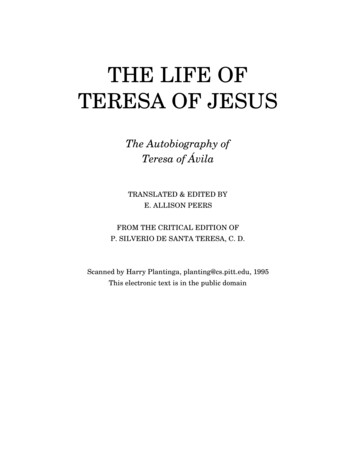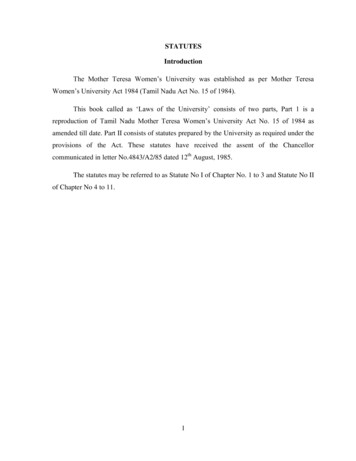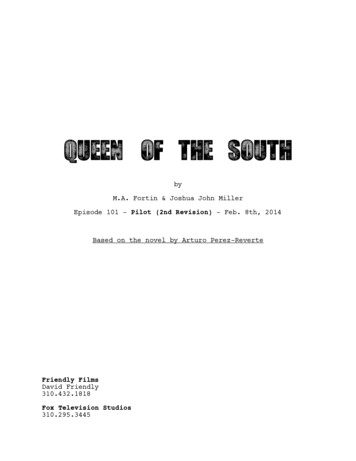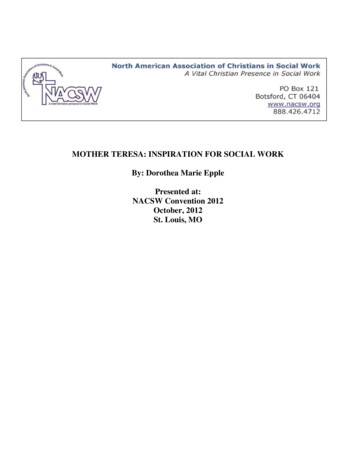
Transcription
The Life of St. Teresa of Jesusof The Order of Our Lady of CarmelWritten by herself:St.Teresa of Avila
The Life of St. Teresa of Jesus, of The Order of Our Lady ofCarmelSaint Teresa of AvilaTable of ContentsAbout This Book. . . . . . . . .Frontispiece. . . . . . . . . . . .Title Page. . . . . . . . . . . . .Contents. . . . . . . . . . . . . .Introduction. . . . . . . . . . . .St. Teresa's Arguments of thePreface. . . . . . . . . . . . . . .Annals of the Saint's Life. . . .The Life. . . . . . . . . . . . . . .Prologue. . . . . . . . . . . . .Chapter I. . . . . . . . . . . . .Chapter II. . . . . . . . . . . .Chapter III. . . . . . . . . . . .Chapter IV. . . . . . . . . . . .Chapter V. . . . . . . . . . . .Chapter VI. . . . . . . . . . . .Chapter VII. . . . . . . . . . .Chapter VIII. . . . . . . . . . .Chapter IX. . . . . . . . . . . .Chapter X. . . . . . . . . . . .Chapter XI. . . . . . . . . . . .Chapter XII. . . . . . . . . . .Chapter XIII. . . . . . . . . . .Chapter XIV. . . . . . . . . . .Chapter XV. . . . . . . . . . .Chapter XVI. . . . . . . . . . .Chapter XVII. . . . . . . . . .Chapter XVIII. . . . . . . . . .Chapter XIX. . . . . . . . . . .Chapter XX. . . . . . . . . . .Chapter XXI. . . . . . . . . . .Chapter XXII. . . . . . . . . .Chapter XXIII. . . . . . . . . .Chapter XXIV. . . . . . . . . .Chapter XXV. . . . . . . . . .Chapters.iii.p. iip. 1p. 2p. 3p. 6p. 17p. 21p. 33p. 35p. 35p. 35p. 38p. 40p. 42p. 46p. 50p. 54p. 62p. 66p. 69p. 72p. 78p. 80p. 87p. 91p. 96p. 99p. 103p. 107p. 112p. 121p. 125p. 131p. 137p. 139
The Life of St. Teresa of Jesus, of The Order of Our Lady ofCarmelSaint Teresa of AvilaChapter XXVI. . . . . . . . . . . . . . .Chapter XXVII. . . . . . . . . . . . . .Chapter XXVIII. . . . . . . . . . . . . .Chapter XXIX. . . . . . . . . . . . . . .Chapter XXX. . . . . . . . . . . . . . .Chapter XXXI. . . . . . . . . . . . . . .Chapter XXXII. . . . . . . . . . . . . .Chapter XXXIII. . . . . . . . . . . . . .Chapter XXXIV. . . . . . . . . . . . . .Chapter XXXV. . . . . . . . . . . . . .Chapter XXXVI. . . . . . . . . . . . . .Chapter XXXVII. . . . . . . . . . . . .Chapter XXXVIII. . . . . . . . . . . . .Chapter XXXIX. . . . . . . . . . . . . .Chapter XL. . . . . . . . . . . . . . . .The Relations. . . . . . . . . . . . . . . .Relation I. . . . . . . . . . . . . . . . . .Relation II. . . . . . . . . . . . . . . . .Relation III. . . . . . . . . . . . . . . . .Relation IV. . . . . . . . . . . . . . . . .Relation V. . . . . . . . . . . . . . . . .Relation VI. . . . . . . . . . . . . . . . .Relation VII. . . . . . . . . . . . . . . .Relation VIII. . . . . . . . . . . . . . . .Relation IX. . . . . . . . . . . . . . . . .Relation X. . . . . . . . . . . . . . . . .Relation XI. . . . . . . . . . . . . . . . .Index. . . . . . . . . . . . . . . . . . . . .Indexes. . . . . . . . . . . . . . . . . . . .Index of Scripture References. . . .Index of Citations. . . . . . . . . . . .Latin Words and Phrases. . . . . . .French Words and Phrases. . . . . .Index of Pages of the Print Edition.iv.p. 146p. 149p. 155p. 161p. 166p. 173p. 180p. 185p. 191p. 197p. 202p. 211p. 215p. 223p. 231p. 239p. 239p. 246p. 249p. 254p. 256p. 259p. 261p. 266p. 271p. 276p. 277p. 280p. 291p. 291p. 292p. 294p. 299p. 299
The Life of St. Teresa of Jesus, of The Order of Our Lady ofCarmeliThe LifeofSt. Teresa of JesusRe-imprimatur.ii FranciscusArchiepiscopus Westmonast.Die 27 Sept., 1904.Saint Teresa of Avila
The Life of St. Teresa of Jesus, of The Order of Our Lady ofCarmelSaint Teresa of AvilaThe LifeiiiofSt. Teresa of Jesus,of the Order of Our Lady of Carmel.Written by Herself.Translated from the Spanish byDavid Lewis.Third Edition Enlarged.With additional Notes and an Introduction byRev. Fr. Benedict Zimmerman, O.C.D.London:Thomas BakerNew York:Benziger Bros.MCMIV.2
The Life of St. Teresa of Jesus, of The Order of Our Lady ofCarmelvviSaint Teresa of AvilaContents.Chap.Introduction to the Third Edition, by Rev. B. ZimmermanSt. Teresa's Arguments of the ChaptersPreface by David LewisAnnals of the Saint's LifePrologueI. Childhood and early Impressions—The Blessing of pious Parents—Desire ofMartyrdom—Death of the Saint's MotherII. Early Impressions—Dangerous Books and Companions—The Saint is placed in a MonasteryIII. The Blessing of being with good people—How certain Illusions were removedIV. Our Lord helps her to become a Nun—Her many InfirmitiesV. Illness and Patience of the Saint—The Story of a Priest whom she rescued from a Life ofSinVI. The great Debt she owed to our Lord for His Mercy to her—She takes St. Joseph for herPatronVII. Lukewarmness—The Loss of Grace—Inconvenience of Laxity in Religious HousesVIII. The Saint ceases not to pray—Prayer the way to recover what is lost—All exhorted topray—The great Advantage of Prayer, even to those who may have ceased from itIX. The means whereby our Lord quickened her Soul, gave her Light in her Darkness, and madeher strong in GoodnessX. The Graces she received in Prayer—What we can do ourselves—The great Importance ofunderstanding what our Lord is doing for us—She desires her Confessors to keep her Writingssecret, because of the special Graces of our Lord to her, which they had commanded her to describeXI. Why men do not attain quickly to the perfect Love of God—Of Four Degrees of Prayer—Ofthe First Degree—The Doctrine profitable for Beginners, and for those who have no sensibleSweetnessXII. What we can ourselves do—The Evil of desiring to attain to supernatural States before ourLord calls usXIII. Of certain Temptations of Satan—Instructions relating theretoXIV. The Second State of Prayer—Its supernatural CharacterXV. Instructions for those who have attained to the Prayer of Quiet—Many advance so far, butfew go fartherXVI. The Third State of Prayer—Deep Matters—What the Soul can do that has reachedit—Effects of the great Graces of our LordXVII. The Third State of Prayer—The Effects thereof—The Hindrance caused by the Imaginationand the MemoryXVIII. The Fourth State of Prayer—The great Dignity of the Soul raised to it by ourLord—Attainable on Earth, not by our Merit, but by the Goodness of our LordXIX. The Effects of this Fourth State of Prayer—Earnest Exhortations to those who have attainedto it not to go back nor to cease from Prayer, even if they fall—The great Calamity of going back3
The Life of St. Teresa of Jesus, of The Order of Our Lady ofCarmelSaint Teresa of AvilaXX. The Difference between Union and Rapture—What Rapture is—The Blessing it is to theSoul—The Effects of itXXI. Conclusion of the Subject—Pain of the Awakening—Light against DelusionsXXII. The Security of Contemplatives lies in their not ascending to high Things if our Lorddoes not raise them—The Sacred Humanity must be the Road to the highest Contemplation—ADelusion in which the Saint was once entangledXXIII. The Saint resumes the History of her Life—Aiming at Perfection—Means whereby itmay be gained—Instructions for ConfessorsXXIV. Progress under Obedience—Her Inability to resist the Graces of God—God multipliesHis GracesXXV. Divine Locutions—Delusions on that SubjectXXVI. How the Fears of the Saint vanished—How she was assured that her Prayer was theWork of the Holy SpiritXXVII. The Saint prays to be directed in a different way—Intellectual VisionsXXVIII. Visions of the Sacred Humanity and of the glorified Bodies—Imaginary Visions—GreatFruits thereof when they come from GodXXIX. Of Visions—The Graces our Lord bestowed on the Saint—The Answers our Lord gaveher for those who tried herXXX. St. Peter of Alcantara comforts the Saint—Great Temptations and Interior TrialsXXXI. Of certain outward Temptations and Appearances of Satan—Of the Sufferings therebyoccasioned—Counsels for those who go on unto PerfectionXXXII. Our Lord shows St. Teresa the Place which she had by her Sins deserved in Hell—TheTorments there—How the Monastery of St. Joseph was foundedXXXIII. The Foundation of the Monastery hindered—Our Lord consoles the SaintXXXIV. The Saint leaves her Monastery of the Incarnation for a time, at the command of hersuperior—Consoles an afflicted WidowXXXV. The Foundation of the House of St. Joseph—Observance of holy Poverty therein—Howthe Saint left ToledoXXXVI. The Foundation of the Monastery of St. Joseph—Persecution and Temptations—Greatinterior Trial of the Saint, and her DeliveranceXXXVII. The Effects of the divine Graces in the Soul—The inestimable Greatness of oneDegree of GloryXXXVIII. Certain heavenly Secrets, Visions, and Revelations—The Effects of them in her SoulXXXIX. Other Graces bestowed on the Saint—The Promises of our Lord to her—DivineLocutions and VisionsXL. Visions, Revelations, and LocutionsThe Relations.viiRelation.I. Sent to St. Peter of Alcantara in 1560 from the Monastery of the Incarnation, AvilaII. To one of her Confessors, from the House of Doña Luisa de la Cerda, in 1562III. Of various Graces granted to the Saint from the year 1568 to 1571, inclusiveIV. Of the Graces the Saint received in Salamanca at the end of Lent, 1571V. Observations on certain Points of Spirituality4
The Life of St. Teresa of Jesus, of The Order of Our Lady ofCarmelSaint Teresa of AvilaVI. The Vow of Obedience to Father Gratian which the Saint made in 1575VII. Made for Rodrigo Alvarez, S.J., in the year 1575, according to Don Vicente de la Fuente;but in 1576, according to the Bollandists and F. BouixVIII. Addressed to F. Rodrigo AlvarezIX. Of certain spiritual Graces she received in Toledo and Avila in the years 1576 and 1577X. Of a Revelation to the Saint at Avila, 1579, and of Directions concerning the Governmentof the OrderXI. Written from Palencia in May, 1581, and addressed to Don Alonzo Velasquez, Bishop ofOsma, who had been when Canon of Toledo, one of the Saint's Confessors5
The Life of St. Teresa of Jesus, of The Order of Our Lady ofCarmelIntroduction to the Present Edition.ixxSaint Teresa of AvilaWhen the publisher entrusted me with the task of editing this volume, one sheet was alreadyprinted and a considerable portion of the book was in type. Under his agreement with the ownersof the copyright, he was bound to reproduce the text and notes, etc., originally prepared by Mr.David Lewis without any change, so that my duty was confined to reading the proofs and verifyingthe quotations. This translation of the Life of St. Teresa is so excellent, that it could hardly beimproved. While faithfully adhering to her wording, the translator has been successful in renderingthe lofty teaching in simple and clear language, an achievement all the more remarkable as inaddition to the difficulty arising from the transcendental nature of the subject matter, the involvedstyle, and the total absence of punctuation tend to perplex the reader. Now and then there might besome difference of opinion as to how St. Teresa's phrases should be construed, but it is not toomuch to say that on the whole Mr. Lewis has been more successful than any other translator, whetherEnglish or foreign. Only in one case have I found it necessary to make some slight alteration in thetext, and I trust the owners of the copyright will forgive me for doing so. In Chapter XXV., § 4,St. Teresa, speaking of the difference between the Divine and the imaginary locutions, says that aperson commending a matter to God with great earnestness, may think that he hears whether hisprayer will be granted or not: y es muy posible, "and this is quite possible," but he who has everheard a Divine locution will see at once that this assurance is something quite different. Mr. Lewis,following the old Spanish editions, translated "And it is most impossible," whereas both the autographand the context demand the wording I have ventured to substitute.When Mr. Lewis undertook the translation of St. Teresa's works, he had before him Don Vicentede la Fuente's edition (Madrid, 1861–1862), supposed to be a faithful transcript of the original. In1873 the Sociedad Foto-Tipografica-Catolica of Madrid published a photographic reproduction ofthe Saint's autograph in 412 pages in folio, which establishes the true text once for all. Don Vicenteprepared a transcript of this, in which he wisely adopted the modern way of spelling but otherwisepreserved the original text, or at least pretended to do so, for a minute comparison between autographand transcript reveals the startling fact that nearly a thousand inaccuracies have been allowed tocreep in. Most of these variants are immaterial, but there are some which ought not to have beenoverlooked. Thus, in Chapter XVIII. § 20, St. Teresa's words are: Un gran letrado de la orden delglorioso santo Domingo, while Don Vicente retains the old reading De la orden del gloriosopatriarca santo Domingo. Mr. Lewis possessed a copy of this photographic reproduction, bututilised it only in one instance in his second edition.1The publication of the autograph has settled a point of some importance. The Bollandists (n.1520), discussing the question whether the headings of the chapters (appended to this Introduction)are by St. Teresa or a later addition, come to the conclusion (against the authors of the Reforma delos Descalços) that they are clearly an interpolation (clarissime patet) on account of the praise ofthe doctrine contained in these arguments. Notwithstanding their high authority the Bollandists arein this respect perfectly wrong, the arguments are entirely in St. Teresa's own hand and areexclusively her own work. The Book of Foundations and the Way of Perfection contain similararguments in the Saint's handwriting. Nor need any surprise be felt at the alleged praise of her11. Chap. xxxiv., note 5.6
The Life of St. Teresa of Jesus, of The Order of Our Lady ofCarmelxiSaint Teresa of Aviladoctrine for by saying: this chapter is most noteworthy (Chap. XIV.), or: this is good doctrine(Chap. XXI.), etc., she takes no credit for herself because she never grows tired of repeating thatshe only delivers the message she has received from our Lord.2 The Bollandists, not having seenthe original, may be excused, but P. Bouix (whom Mr. Lewis follows in this matter) had no rightto suppress these arguments. It is to be hoped that future editions of the works of S. Teresa will notagain deprive the reader of this remarkable feature of her writings. What she herself thought of herbooks is best told by Yepes in a letter to Father Luis de Leon, the first editor of her works: "Shewas pleased when her writings were being praised and her Order and the convents were held inesteem. Speaking one day of the Way of Perfection, she rejoiced to hear it praised, and said to mewith great content: Some grave men tell me that it is like Holy Scripture. For being revealed doctrineit seemed to her that praising her book was like praising God."3A notable feature in Mr. Lewis's translation is his division of the chapters into short paragraphs.But it appears that he rearranged the division during the process of printing, with the result that alarge number of references were wrong. No labour has been spared in the correction of these, andI trust that the present edition will be the more useful for it. In quoting the Way of Perfection andthe Interior Castle (which he calls Inner Fortress!) Mr. Lewis refers to similar paragraphs which,however, are to be found in no English edition. A new translation of these two works is greatlyneeded, and, in the case of the Way of Perfection, the manuscript of the Escurial should be consultedas well as that of Valladolid. Where the writings of S. John of the Cross are quoted by volume andpage, the edition referred to is the one of 1864, another of Mr. Lewis's masterpieces. The chaptersin Ribera's Life of St. Teresa refer to the edition in the Acts of the Saint by the Bollandists. Theseand all other quotations have been carefully verified, with the exception of those taken from theworks on Mystical theology by Antonius a Spiritu Sancto and Franciscus a S. Thoma, which I wasunable to consult. I should have wished to replace the quotations from antiquated editions of theLetters of our Saint by references to the new French edition by P. Grégoire de S. Joseph (Paris,Poussielgue, 1900), which may be considered as the standard edition.In note 2 to Chap. XI. Mr. Lewis draws attention to a passage in a sermon by S. Bernardcontaining an allusion to different ways of watering a garden similar to St. Teresa's well-knowncomparison. Mr. Lewis's quotation is incorrect, and I am not certain what sermon he may have hadin view. Something to the point may be found in sermon 22 on the Canticle (Migne, P. L. Vol.CLXXXIII, p. 879), and in the first sermon on the Nativity of our Lord (ibid., p. 115), and also ina sermon on the Canticle by one of St. Bernard's disciples (Vol. CLXXXIV., p. 195). I am indebtedto the Very Rev. Prior Vincent McNabb, O.P., for the verification of a quotation from St. VincentFerrer (Chap. XX. § 31).Since the publication of Mr. Lewis's translation the uncertainty about the date of St. Teresa'sprofession has been cleared up. Yepes, the Bollandists, P. Bouix, Don Vicente de la Fuente, Mr.Lewis, and numerous other writers assume that she entered the convent of the Incarnation4 onNovember 2nd, 1533, and made her profession on November 3rd, 1534. The remaining dates of234Chap. xviii. § 11.Fuente, Obras (1881), vol. vi. p. 133.See the licence granted by Leo X. to the prioress and convent of the Incarnation to build another house for the use of thesaid convent, and to migrate thither (Vatican Archives, Dataria, Leo X., anno i., vol. viii., fol. 82). Also a licence to sell orexchange certain property belonging to it (ibid., anno iv., vol. vii., f. 274; and a charge to the Bishop of Avila concerning arecourse of the said convent (ibid., anno vii., vol. iv., f. 24).7
The Life of St. Teresa of Jesus, of The Order of Our Lady ofCarmelxiixiiiSaint Teresa of Avilaevents previous to her conversion are based upon this, as will he seen from the chronology printedby Mr. Lewis at the end of his Preface and frequently referred to in the footnotes. It rests, however,on inadequate evidence, namely on a single passage in the Life5 where the Saint says that she wasnot yet twenty years old when she made her first supernatural experience in prayer. She was twentyin March, 1535, and as this event took place after her profession, the latter was supposed by Yepesand his followers to have taken place in the previous November. Even if we had no further evidence,the fact that St. Teresa is not always reliable in her calculation should have warned us not to relytoo much upon a somewhat casual statement. In the first chapter, § 7, she positively asserts thatshe was rather less than twelve years old at the death of her mother, whereas we know that she wasat least thirteen years and eight months old. As to the profession we have overwhelming evidencethat it took place on the 3rd of November, 1536, and her entrance in the convent a year and a dayearlier. To begin with, we have the positive statement of her most intimate friends, Julian d'Avila,Father Ribera, S.J., and Father Jerome Gratian. Likewise doña Maria Pinel, nun of the Incarnation,says in her deposition: "She (Teresa of Jesus) took the habit on 2 November, 1535."6 This iscorroborated by various passages in the Saint's writings. Thus, in Relation VII., written in 1575,she says, speaking of herself: "This nun took the habit forty years ago." Again in a passage of theLife written about the end of 1564 or the beginning of the following year,7 she mentions that shehas been a nun for over twenty-eight years, which points to her profession in 1536. But there aretwo documents which place the date of profession beyond dispute, namely the act of renunciationof her right to the paternal inheritance and the deed of dowry drawn up before a public notary. Bothbear the date 31 October, 1536. The authors of the Reforma de los Descalços thought that theymust have been drawn up before St. Teresa took the habit, and therefore placed this event in 1536and the profession in 1537, but neither of these documents is necessarily connected with the clothing,yet both must have been completed before profession. The Constitutions of Blessed John Soreth,drawn up in 1462, which were observed at the convent of the Incarnation, contain the followingrule with regard to the reception and training of novices:8 Consulimus quod recipiendus antesusceptionem habitus expediat se de omnibus quae habet in saeculo nisi ex causa rationabili perpriorem generalem vel provincialem fuerit aliter ordinatum. There was, indeed, good reason in thecase of St. Teresa to postpone these legal matters. Her father was much opposed to her becominga nun, but considering his piety it might have been expected that before the end of the year of5678Chap. iv § 9.Lettres de Ste. Thérèse, edit. P. Grégoire de S. Joseph, vol. iii, p. 419, note 2.Chap. xxxvi. § 10. The date of this part of the Life can be easily ascertained from the two following chapters. In xxxvii. §18, St. Teresa says that she is not yet fifty years old, consequently the chapter must have been written before the end of March,1565; and in the next chapter, xxxviii. § 15, she speaks of the death of Father Pedro Ibañez, which appears to have taken placeon 2nd February. This, at least, is the date under which his name appears in the Année Dominicaine, and the Very Rev. PriorVincent McNabb tells me that there is every reason to think that it is the date of his death.When about A.D. 1452 certain communities of Beguines demanded affiliation to the Carmelite Order, they were given theConstitutions of the friars without any alterations. These Constitutions were revised in 1462, but neither there nor in the Acts ofthe General Chapters, so far as these are preserved, is there the slightest reference to convents of nuns. The colophon of theprinted edition (Venice, 1499) shows that they held good for friars and nuns: Expliciunt sacrae constitutiones novae fratrum etsororum beatae Mariae de Monte Carmelo. They contain the customary laws forbidding the friars [note continues, p. xiii.] underpain of excommunication, to leave the precincts of their convents without due licence, but do not enjoin strict enclosure, whichwould have been incompatible with their manner of life and their various duties. St. Teresa nowhere insinuates that theConstitutions, such as they were, were not kept at the Incarnation; her remarks in chap. vii. are aimed at the Constitutionsthemselves, which were never made for nuns, and therefore did not provide for the needs of their convents.8
The Life of St. Teresa of Jesus, of The Order of Our Lady ofCarmelxivSaint Teresa of Avilaprobation he would grant his consent (which in the event he did the very day she took the habit),and make arrangements for the dowry. One little detail concerning her haste in entering the conventhas been preserved by the Reforma and the Bollandists,9 though neither seem to have understoodits meaning. On leaving the convent of the Incarnation for St. Joseph's in 1563, St. Teresa handedthe prioress of the former convent a receipt for her bedding, habit and discipline. This almostludicrous scrupulosity was in conformity with a decision of the general chapter of 1342 which said:Ingrediens ordinem ad sui ipsius instantiam habeat lectisternia pro se ipso, sin autem recipienssolvat lectum illum. As St. Teresa entered the convent without the knowledge of her father she didnot bring this insignificant trousseau with her; accordingly the prioress became responsible for itand obtained a receipt when St. Teresa went to the new convent. The dowry granted by AlphonsoSanchez de Cepeda to his daughter consisted of twenty-five measures, partly wheat, partly barley,or, in lieu thereof, two hundred ducats per annum. Few among the numerous nuns of the Incarnationcould have brought a better or even an equal dowry.The date of St. Teresa's profession being thus fixed on the 3rd of November, 1536, some otherdates of the chronology must be revised. Her visit to Castellanos de la Cañada must have takenplace in the early part of 1537. But already before this time the Saint had an experience whichshould have proved a warning to her, and the neglect of which she never ceased to deplore, namelythe vision of our Lord;10 her own words are that this event took place "at the very beginning of heracquaintance with the person" who exercised so dangerous an influence upon her. Mr. Lewis assignsto it the date 1542, which is impossible seeing that instead of twenty-six it was only twenty-twoyears before she wrote that passage of her life. Moreover, it would have fallen into the midst of herlukewarmness (according to Mr. Lewis's chronology) instead of the very beginning. P. Bouix rightlyassigns it to the year 1537, but as he is two years in advance of our chronology it does not agreewith the surrounding circumstances as described by him. Bearing in mind the hint St. Teresa gives11as to her disposition immediately after her profession, we need not be surprised if the first roots ofher lukewarmness show themselves so soon.From Castellanos she proceeded to Hortigosa on a visit to her uncle. While there she becameacquainted with the book called Tercer Abecedario. Don Vicente remarks that the earliest editionknown to him was printed in 1537, which tells strongly against the chronology of the Bollandists,P. Bouix, and others. Again, speaking of her cure at Bezadas she gives a valuable hint by sayingthat she remained blind to certain dangers for more than seventeen years until the Jesuit fathersfinally undeceived her. As these came to Avila in 1555 the seventeen years lead us back to 1538,which precisely coincides with her sojourn at Bezadas. She remained there until Pascua florida ofthe following year. P. Bouix and others understand by this term Palm Sunday, but Don Vicenteshows good reason that Easter Sunday is meant, which in 1539 was April the 6th. She then returnedto Avila, more dead than alive, and remained seriously ill for nearly three years, until she was curedthrough the miraculous intervention of St. Joseph about the beginning of 1542. Now began theperiod of lukewarmness which was temporally interrupted by the illness and death of her father,in 1544 or 1545, and came to an end about 1555. Don Vicente, followed by Mr. Lewis, drawsattention to what he believes to be a "proof of great laxity of the convent," that St. Teresa should91011Reforma lib. i., cap. 47. Bollandists. no. 366.Chap. vii. § 11.Chap. v. § 2.9
The Life of St. Teresa of Jesus, of The Order of Our Lady ofCarmelxvSaint Teresa of Avilahave been urged by one of her confessors to communicate as often as once a fortnight. It shouldbe understood that frequent communion such as we now see it practised was wholly unknown inher time. The Constitutions of the Order specified twelve days on which all those that were notpriests should communicate, adding: Verumtamen fratres professi prout Deus eis devotionemcontulerit diebus dominicis et festis duplicibus (i.e., on feasts of our Lady, the Apostles, etc.),communicare poterunt si qui velint. Thus, communicating about once a month St. Teresa acted asordinary good Religious were wont to do, and by approaching the sacrament more frequently sheplaced herself among the more fervent nuns.12St. Teresa wrote quite a number of different accounts of her life. The first, addressed to FatherJuan de Padranos, S.J.13 and dated 1557, is now lost. The second, written for St. Peter of Alcantara,is Relation I. at the end of this volume; a copy of it, together with a continuation (Relation II.) wassent to Father Pedro Ibañez in 1562. It is somewhat difficult to admit that in the very same yearshe wrote another, more extensive, account to the same priest, which is generally called the "first"Life. At the end of the Life such as we have it now, St. Teresa wrote: "This book was finished inJune, 1562," and Father Bañez wrote underneath: "This date refers to the first account which theHoly Mother Teresa of Jesus wrote of her life; it was not then divided into chapters. Afterwardsshe made this copy and inserted in it many things which had
St. Teresa's Arguments of the Chapters Preface by David Lewis Annals of the Saint's Life Prologue I. Childhood and early Impressions—The Blessing of pious Parents—Desire of Martyrdom—Death of the Saint's Mother II. Early Impressions—Dangerous Boo










